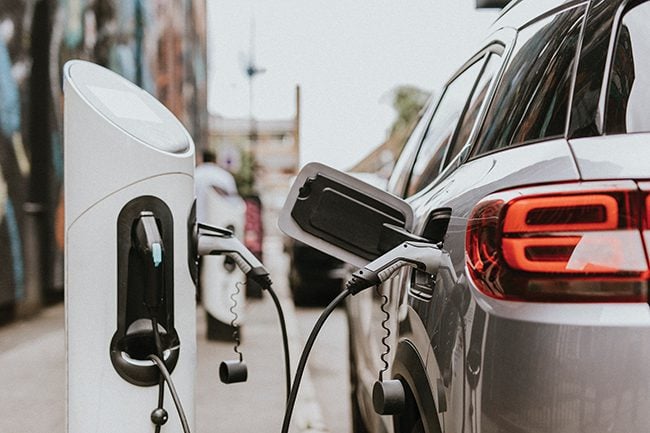Patent Filings Provide Clues to Future of EV Batteries

We are in the preliminary stages of an historic transition from internal combustion engine (ICE) vehicles to battery electric vehicles (BEVs). The transition will be expensive and difficult in many ways. Innovation should ease this transition. Recently filed patent applications may provide clues about the direction of BEV innovation.
COMMENTARY
Most U.S. patent applications are published by the U.S. Patent and Trademark Office (USPTO) soon after they are filed. This article focuses only on USPTO patent applications, which also reflect BEV innovation just as well as patents filed in other patent offices around the world.

A U.S. patent grants its owner the right to stop others from making, using, selling, or importing products in the U.S. that are covered by the patent. A patent can be asserted against a competing product regardless of whether the product was created without knowledge of the patent. A patent can be an extremely valuable, and it can be exploited by its owner through litigation, licensing to third parties, or other means.
BEVs are powered entirely by electricity. A BEV power train typically includes a traction inverter electrically connected between a rechargeable battery and an electric motor. The battery provides DC power. The electric motor needs AC power to operate. The traction inverter converts DC power from the battery into AC power for the electric motor. The traction inverter also controls the speed and torque of the electric motor.

Batteries are the most important and expensive component of the BEV power train. Batteries are characterized by many factors including cost, recharging time, energy density, power density, safety, and lifespan. Smaller and lighter batteries reduce the cost and weight of BEVs. However, smaller batteries lack the capacity needed to assuage driver range anxiety.
Currently lithium-ion batteries are favored for BEVs. In 2022, numerous press releases announced plans to create new factories in the U.S. for manufacturing lithium-ion batteries. Such announcements increased soon after passage of U.S. Inflation Reduction Act, which places emphasis on domestically-sourced BEV batteries.

Lithium-ion batteries consist of an electrolyte, anode, and cathode. The electrolyte is where ions are exchanged between the anode and cathode while the battery is charged or discharged. Several different materials can be used for the electrolyte and electrodes (i.e., anode and cathode), each with their own advantages and disadvantages. These include:
- Lithium Cobalt Oxide
- Lithium Manganese Oxide
- Lithium Iron Phosphate
- Lithium Nickel Manganese Cobalt Oxide
- Lithium Nickel Cobalt Aluminum Oxide
- Lithium Titanate
The USPTO database indicates a total of 4,301 U.S. patent applications have been filed, which relate to lithium-ion batteries. A number of these patent applications may be directed to peripheral aspects of lithium-ion batteries including methods of recycling, monitoring, etc. However, most of the 4,301 patents are directed to the composition, structure, and methods of manufacturing lithium-ion batteries.

Nearly 40% of the 4,301 patent applications were filed during the last five years, which suggests that innovation in lithium-ion battery technology continues at a rapid pace. This also suggests that lithium-ion batteries will play an important role in BEVs for the foreseeable future. The chart below shows a geographic breakdown by applicant country of lithium-ion battery related patent applications that were filed in the U.S. during the last five years. It seems Japan has taken a leading role in the development of lithium-ion batteries since 2017.
Notwithstanding the importance of lithium-ion battery technology, the USPTO is seeing an increase in the rate at which U.S. patent applications directed to alternative battery technologies are filed, such as solid-state batteries. In contrast to lithium-ion batteries, solid-state batteries use solid-state electrolytes to transfer lithium-ions between the anode and cathode. Solid-state electrolytes provide batteries with a higher energy densities, longer lifespan, and better safety. However, there are some concerns about the price and complexity of manufacturing solid-state batteries at scale.

The USPTO database indicates a total of 1,302 U.S. patent applications related to solid-state batteries were filed, with nearly 74% of those filed during the last five years. The chart below shows a breakdown by applicant country of solid-state battery patent applications during the last five years. Again, Japan leads the charge in the development of solid-state batteries.
The traction inverter is another important and expensive component of the BEV drive train. Traction inverters, as noted above, convert DC power to AC power for operation of an electric motor. A traction inverter typically includes three phases or legs, each of which includes a high-side switch connected to a low-side switch, the combination of which is connected in series between the positive and negative terminals of a battery. The switches conduct current when turned on. The switches receive activation signals from a microprocessor or similar device. Through coordinated activation of high-side and low-side switches, current flow in the stator windings at each phase to create a rotating magnetic field that interacts with a rotor. The rotor in turn creates torque on a drive shaft.
The switches greatly affect the cost, size, weight, power density, and efficiency of a traction inverter. Silicon insulated-gate bipolar transistors (IGBTs) are currently the preferred switch employed in traction inverters. Silicon IGBTs are cheap and plentiful, making them the preferred alternative for use in traction inverters. For low switching speeds, silicon IGBTs also offer good efficiency. However, traction inverters are now being designed to operate at higher switching speeds, where silicon IGBTs are less efficient. This, in turn, reduces the overall efficiency of the traction inverters in which silicon IGBTs are employed. A larger thermal management system may also be needed to cool silicon IGBTs operating at higher switching speeds, which in turn adds to the cost, weight, and size of the traction inverter.

The USPTO database indicates a total of 586 U.S. patent applications related to IGBTs, of which 31% were filed during the last five years. The chart below shows a breakdown by applicant country of the most recently filed IGBT patent applications. China and the U.S. appear to be the leading innovators over the last five years.
To date, Silicon Carbide (SiC) and Gallium Nitride (GaN) metal-oxide field effect transistors (MOSFETs) have emerged as the preferred alternative technologies to silicon IGBTs. These semiconductor devices can operate at higher switching speeds (even at high voltages) with lower switching losses, which means less heat generation, thus reducing the requirements and size and cost of thermal management systems.
The USPTO database indicates a total of 1,412 U.S. patent applications have been filed that relate to SiC transistors. Nearly 35% of these patent applications were filed during the last five years. While the U.S. and China are leading the way with innovation related to IGBTs, Japanese companies appear to be placing a greater focus on SiC transistors having filed 59% if the related patent applications within the last five years.

U.S. companies on the other hand appear to have focused more of their efforts on GaN transistor technology. The USPTO database indicates that a total of 1,043 U.S. patent applications have been filed that relate to GaN transistors, but only 17% of those were filed in the last five years. This suggests that SiC transistors may be preferred over GaN transistors for use as alternatives to IGBTs in traction inverters. As the chart below shows, U.S. applicants may think otherwise since American applicants have filed more than half of the U.S. patent applications directed to GaN transistors over the past five years.

In summary, a substantial number of patent applications have been recently filed in the U.S. that are directed to BEV power train innovation. While lithium-ion batteries appear to be the battery of choice for BEVs in the near term, the relatively high number of recently filed patent applications suggest that solid-state batteries may be a viable alternative. Silicon IGBTs are currently the power transistor of choice for use in traction inverters. However, the relatively high number of recently filed patent applications strongly suggest SiC and GaN MOSFETs gaining on IGBTs.
—Sam Campbell, Christopher Kent, and Eric Stephenson are members of Womble Bond Dickinson’s energy team.
The post Patent Filings Provide Clues to Future of EV Batteries appeared first on POWER Magazine.